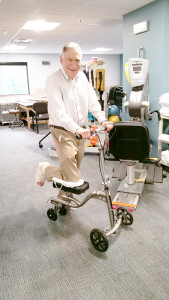Accident Adventures
My injured ankle and subsequent events gave me a great amount of empathy for disabled individuals
By Marvin Druger
 One common sign of aging is losing balance and falling. I’ve often been warned, “Don’t do that. You might fall and break your hip.” I always laughed at such warnings.
One common sign of aging is losing balance and falling. I’ve often been warned, “Don’t do that. You might fall and break your hip.” I always laughed at such warnings.
The other night, I was walking my friend’s dog on a leash in Barry Park, Syracuse. There is a mulched path around the pond, but I didn’t like the feel of the mulch on my feet, so I walked on the grass inside the path. The night was very dark. I had a flashlight, but didn’t use it. I confidently marched along on the grass and came to an area where the grass suddenly banked. I didn’t see the bank and I fell and my ankle twisted to the side.
The dog sensed that something had happened and man’s best friend started licking my face. I got up and laughed and kept walking, until I felt how painful walking had become.
My friend went to get her car and drove me to her house. We looked at the foot. The ankle had blown up as large as an inflated balloon. We drove to the emergency room at a local hospital. An emergency room is like another world. Despite the late hour, people of all sizes, shapes and health problems crowded the room.
The computers were down and I waited several hours until a staff member took my blood pressure and medical history and said, “We’ll be out to get you in a few minutes.” More time passed until another staff member emerged and yelled loudly, “Marion, are you here?” I suspected he meant, “Marvin.” I was right.
A physician’s assistant ordered an X-ray, but the battery needed to be replaced in the device. A while later, the PA announced “You have a fractured ankle.” Impossible, I thought. I never had a broken bone in all of my years of living. They gave me a pair of crutches, adjusted them, recommended an orthopedist, and I was on my way to the world of the disabled.
Surgery was next. I am not a fan of anesthesiology. When the anesthesiologist introduced himself, I shook his hand suspiciously. Full anesthesia and a nerve block injection were administered. I was trying to calm myself down just before the injection, thinking of what peaceful scene I could envision. Then I suddenly was wide awake and the nurse was saying, “It went well.” I was told that I might be groggy after the anesthesia. Instead I was completely lucid.
I was pleased at the lack of pain in my bandaged foot. In the middle of the night, the pain-killing effects of the nerve block suddenly disappeared. The pain became intense. On a scale of one to 10, with 10 being most painful, my pain was an 11.
My daughter called 911, and I was again transported to the emergency room. All sorts of pain-killing drugs were administered, including morphine, with little effect. The foot was re-bandaged, and that seemed to do some good. We were in the emergency room from 1:30 a.m. until 7:30 in the morning.
My injured ankle and subsequent events gave me a great amount of empathy for disabled individuals. How does someone cope with a disabling injury and pursue a normal semblance of living? The orthopedist said that my fracture required surgery. My son said to the orthopedist, “Don’t worry about my dad. He has a high pain tolerance.” How would he know that?
I was sent to a pre-op physical therapist to show me some mobility devices that were available. There were crutches, a walker, a wheelchair and a scooter. The scooter was fun and made me feel like a reckless teenager zooming along on the street. The walker, wheelchair and crutches seemed more practical for mobility in the household.
The therapist held my belt in the back while I used the crutches to descend a long, concrete staircase without carpeting. After descending two steps, I announced, “Forget this method. I can’t do it!” It was scary, and I had visions of tumbling down the steps and crashing my head at the bottom of the staircase. So, I elected to mainly use the walker and wheelchair. The therapist encouraged me by saying, “Now everyone can wait on you.”
The physical therapy visit was followed by an agonizing week of waiting at home for the surgery. There were challenges that were probably common for disabled individuals. Going to the bathroom required strategic thinking. I used one crutch to stagger to the bathroom. Then, I tried to stand up and walk with one crutch. Try it sometime. I fell backwards and smashed my back on the edge of the toilet seat, causing a painful rib injury. The rib injury hurt much more than the fractured ankle.
The next day, I used the walker to get to the bathroom. I tried to turn the walker backwards and it tipped over, throwing me to the ground. This time, the soft carpet saved me.
Also, the walker was too low and caused sharp pain in my ribs whenever I hopped forward. To add to the situation, my fall onto the toilet seat broke the hinges, making sitting on the toilet a perilous event. Constipation added to my woes.
Getting up and down stairs was another challenge that required strategic thinking. My bedroom is upstairs and there are 16 carpeted steps. How do I get up the steps to my bedroom? The answer was simple. I sat down backwards and shimmied up the steps, one step at a time, thus providing lots of exercise for my arms. It was like doing backward pushups.
How to get down the steps was another problem. Fortunately, I have a strong banister on each side of the steps, so I simply hopped down the steps on my good leg, one step at a time.
Then, there was the problem of getting down five steps on the porch, where there was only one banister. I was fearful of hopping down each step with my one good leg with limited support. If I sat down and shimmied down the steps, then how would I stand up when I reached the bottom?
The solution was for me to grab the railing of the porch with one hand and put my other arm around someone’s shoulders, hop down on each step.
Usually, when someone suffers an illness or injury, family members and friends swarm out of the woodwork to help. My family and friends overwhelmed me with attention. They did shifts and someone was with me day and night.
‘I discovered that coping with a physical disability requires ingenuity, strength, courage, perseverance and a positive attitude. Suddenly, simple actions that we take for granted, like walking, become major challenges.’
One morning, I was in my bed upstairs and it was my granddaughter’s turn to watch over me for a few hours. I heard the door open downstairs and my granddaughter entered the house and yelled, “Hi, Grandpa!”
Then, she immediately laid down on the sofa downstairs and went to sleep, without ever coming upstairs to see how I was doing, or if I was in the house at all. I could have been unconscious, but she would never have known.
I discovered that coping with a physical disability requires ingenuity, strength, courage, perseverance and a positive attitude. Suddenly, simple actions that we take for granted, like walking, become major challenges.
I never realized how important it is to be physically and emotionally fit in order to deal with illness or injury. We need motivation and strength for every task.
Oftentimes, it’s not a fall that is a problem for older people. The problem is that they can’t get up. One of my friends told me that he tripped and fell in his house and couldn’t get up. He used his ingenuity and crawled to a closet and got a coat. He covered himself with the coat and lay on the floor for several hours, until his son came home to rescue him.
My broken ankle has been a learning experience and has made me realize how amazing it is to see people with much more severe disabilities adapting to their new lives and still smiling. Somehow, life goes on for them. Now, I tell older people, “Don’t do that. You might fall and break your ankle.”

